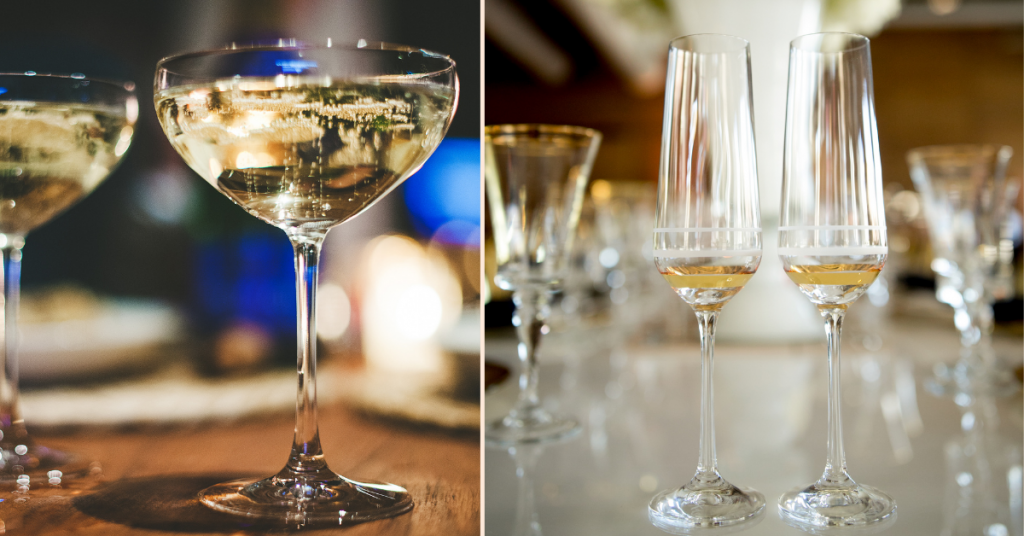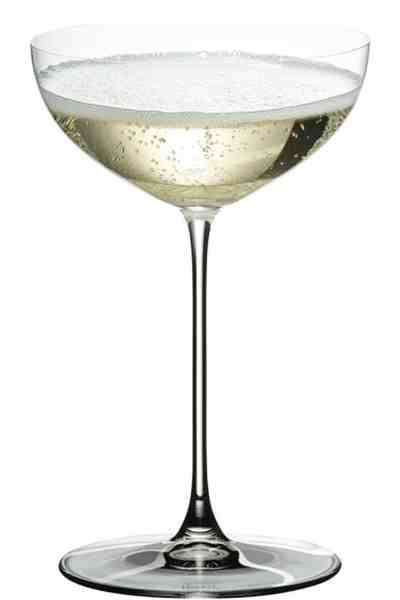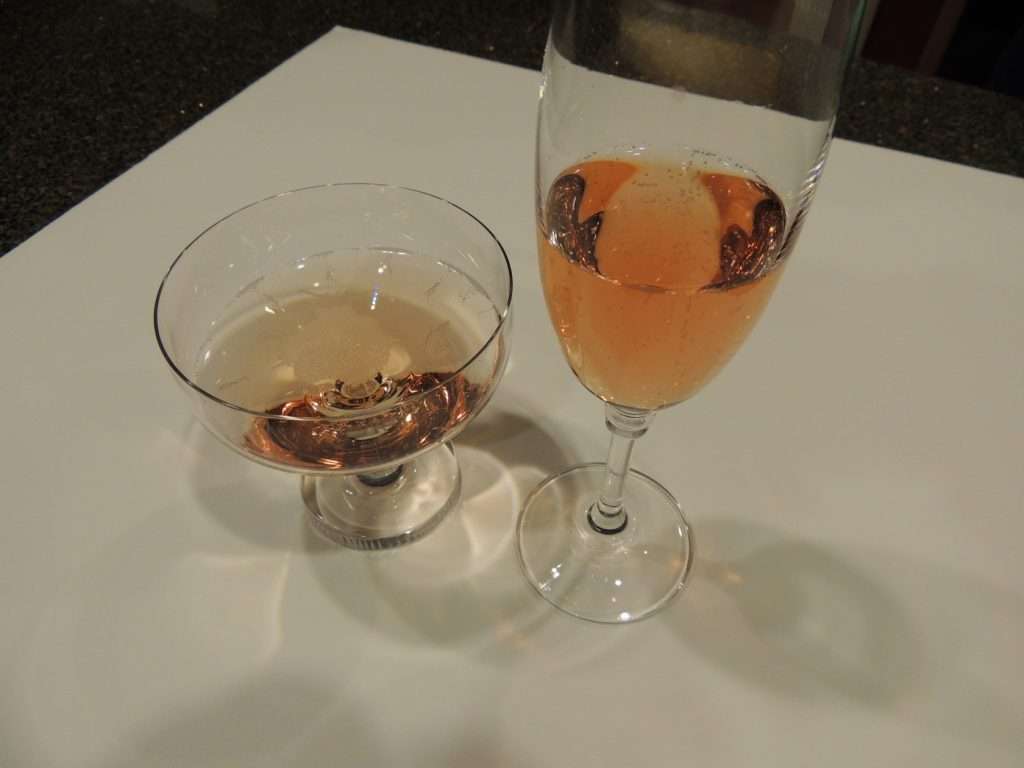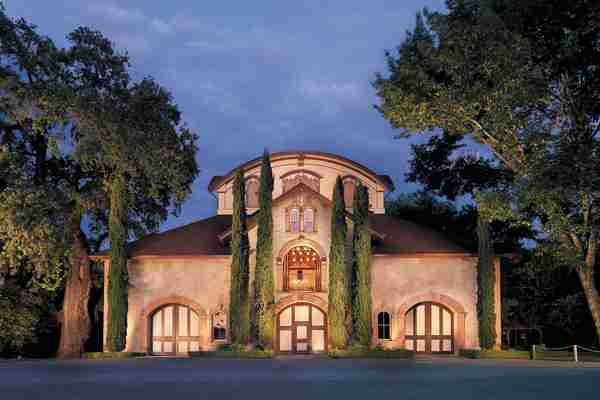Champagne Flute vs. Coupe: The Final Showdown
I love champagne coupes. They’re so chic and elegant, and it’s hard not to feel like Grace Kelly when I’m holding one. Through the 1960s, the coupe was the glass for bubbles.
Lately, coupes have fallen out of favor with wine experts as a champagne glass alternative. The almost unanimous recommendation these days is to use wine flutes (or tulip glasses) to drink champagne.
But coupes just look so damn cool so I decided to test out drinking from a champagne flute vs. a coupe to see if there is really any difference, besides the obvious aesthetic appeal of coupes.

Testing A Champagne Flute vs. Coupe
Not that I don’t trust wine experts, but I’m more of a hands-on learner, so I conducted my own scientific experiment comparing bubbles in coupes vs. bubbles in flutes.
I wore a white lab coat and everything (if the Clinique ladies can get away with it, so can I).
Buy James Bond’s Favorite Champagne
Drinking Champagne From A Coupe
Because coupes are shallow and wide, when you pour Champagne into them, the CO2 rises and dissipates over the area fairly quickly. Look at the way the bubbles congregate and race to the perimeter of the coupe. You can almost hear them shouting, “Abandon ship!!”.
Pros: You look très chic holding a coupe!
Cons: The difference between the coupe and the flute was dramatic. You have about 3 minutes to drink your bubbly before it turns into still wine.
Conclusion: Champagne also gets warm more quickly in a coupe. And warm Champagne tastes bad. And then there’s the spillage problem. Fill a coupe and try to walk across a crowded room without sloshing champagne onto your shoes!
Drinking Champagne From A Flute
Flute glasses are tall and narrow. The smaller surface area slows down the loss of CO2. Your bubbles last longer, and your champagne stays cooler. I love the way the bubbles form vertical streams in the flute, like little ladders.
Pros: Your glass will be empty before your bubbles disappear. And you still look très chic holding a champagne flute!
Cons: Cons??
Conclusion: Use a coupe for cocktails like Lillet Champagne Cocktail or a Prosecco Spritzer. But when you’re enjoying champagne (or other sparkling wine like Prosecco) solo . . . use a flute!




Join thousands of weekly readers!
Get our best food and wine pairings, wine-region travel tips, and Best-Of lists in your inbox weekly, for free!
Coupe Glass History
There’s an old legend that the champagne coupe was modeled after the breast of Marie Antoinette (or Empress Josephine, or Helen of Troy). Almost assuredly false — fodder for Snopes.com.
Champagne Flute History
Champagne flutes are stemmed glasses that are typically used to serve champagne (duh), Prosecco, and other sparkling wines. They are often tulip-shaped with a slender bowl that tapers inward and a tall, narrow stem.
The history of champagne flutes is somewhat uncertain, but it is believed that they were first created in the early 18th century. They may have been modeled after glasses used to serve sparkling wine in the court of Louis XIV.
Champagne flutes became increasingly popular in the 19th century, and they remain a common choice for serving champagne today.
Champagne flutes are designed to maintain the bubbles in champagne, which helps to keep the drink refreshing and effervescent. The glasses are also tall and slender to help prevent the champagne from losing its bubbles too quickly.
Buy Riedel Vintage Champagne Flutes Now On Amazon

Champagne Glass FAQ’s
How do you hold a champagne glass?
In the spirit of not being a wine snob, I say hold it any way you want. That said, if you hold the flute by the stem, your Champagne will stay cool longer and retain its fizz.
Are there stemless champagne flutes?
Absolutely! As a clumsy oaf, I often choose stemless wine glasses assuming I’m less likely to spill my wine. Stemless Champagne flutes are a great choice for the accident-prone or simply less casual drinker. Word of warning, your Champagne will warm more quickly when compared to a traditional flute thanks to the warmth of your hand directly on the glass, rather than down on the stem of a flute.
What to look for when buying champagne flutes?
Champagne flutes come in many different shapes and sizes, but there are a few things to keep in mind when choosing the right one for your needs. There are two standard sizes, the regular size holds about six ounces, and a large glass holds eight ounces.
When It comes to shape, you can choose between straight sides and fluted glasses that have a curve. This choice comes down to personal choice and aesthetics.
Can you serve champagne in a coupe glass?
Of course you can, and it will look really cool! Just be aware that your champagne will get warm and loose it’s fizz quicker when served in a coupe glass compared to champagne served in a flute.
Is Champagne better in a coupe or a flute?
Use a coupe for cocktails like Lillet Champagne Cocktail or a Moscato Spritzer. But when you’re enjoying champagne (or other sparkling wine like Prosecco) solo . . . use a flute!
What is the difference between a coupe and a Champagne glass?
The flute is tall and slender, fun to clink and has a smaller mouth to hold the bubbles longer. The Champagne flute is suitable for any kind of bubbly, whether it’s Champagne, Prosecco, or a sparkling wine. The coupe is shorter and wider than the flute and although it is most certainly a beauty, is better for cocktails.
Can you use a coupe glass for Champagne?
You certainly can however, the coupe is better to be served with a cocktail in it. Flutes are better for bubbles.
What are the 3 types of Champagne glasses?
– Champagne Coupe
– Champagne Flute
– Champagne Tulips









